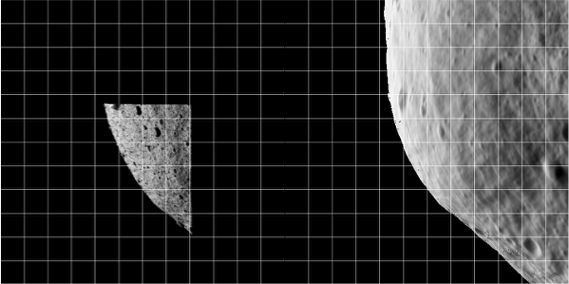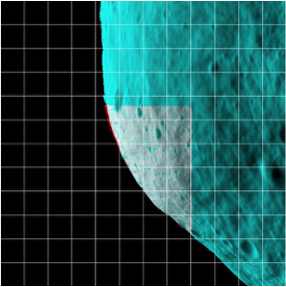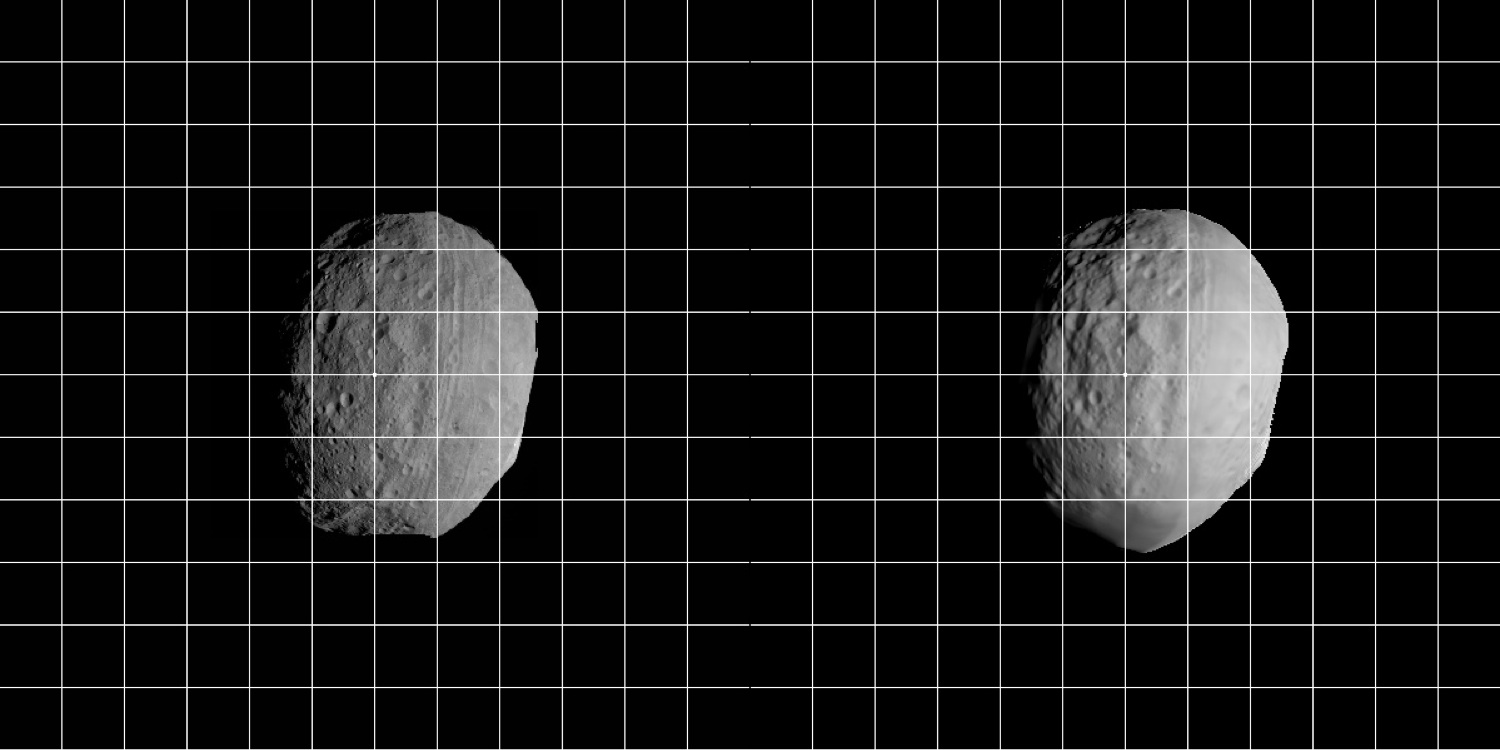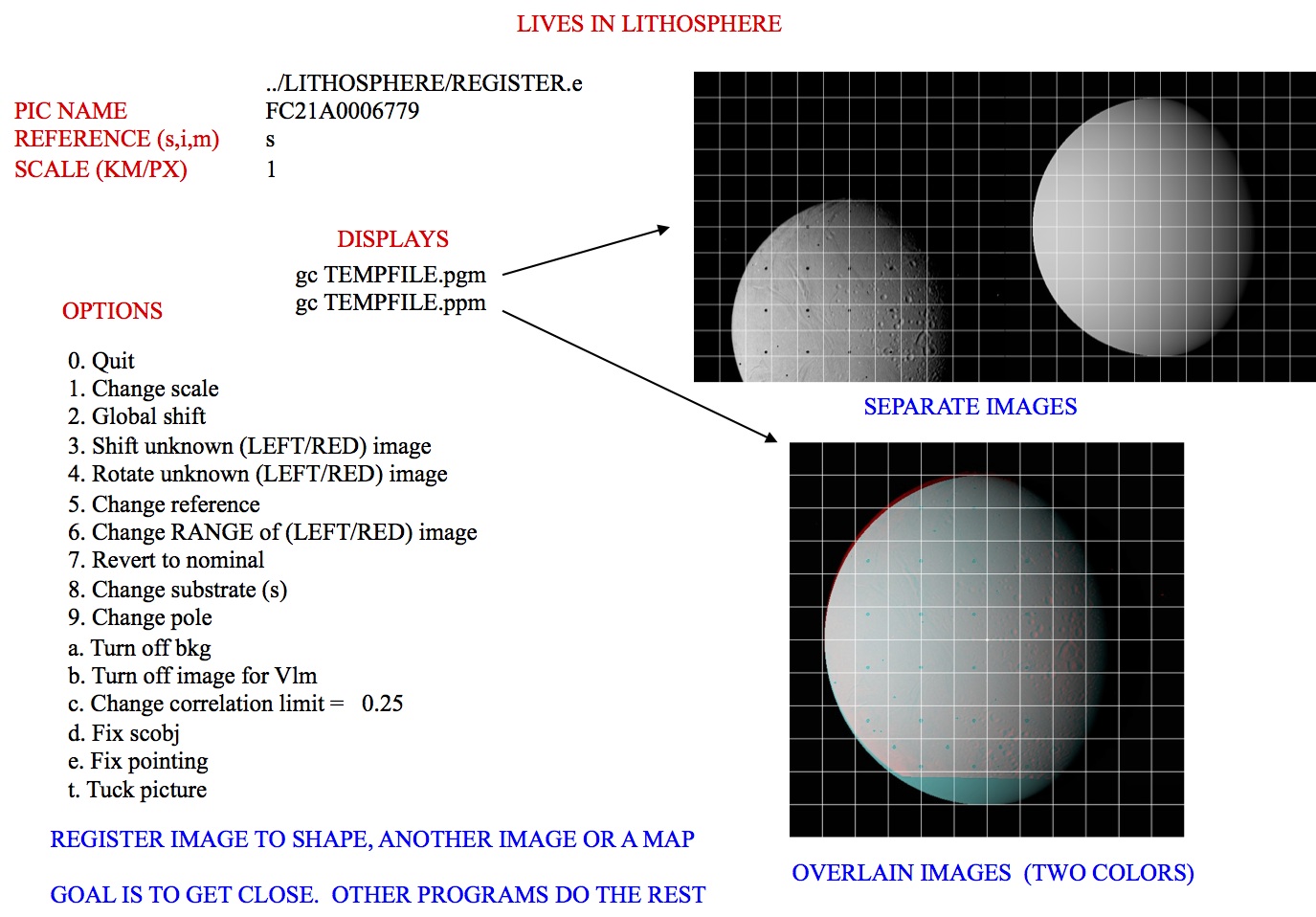register
Category B |
Version 3.0.3 |
Description
This program is used to align new images with a known object.
register cross-correlates an image with existing data to update the knowledge of the spacecraft position/attitude. It is limited to 2 degrees of freedom.
Required Files
IMAGEFILES/ - a directory containing the image .DAT files
NOMINALS/ - a directory containing the image .NOM files (starting solution image, S/C and camera information)
SUMFILES/ - a directory containing the image .SUM files (updated solution image, S/C and camera information, lmrks and limbs)
MAPFILES/ - required for comparison with a reference map
SHAPEFILES/ - required for comparison with a shape model
Optional Files
make_scriptR.seed - for batch processing using make_scriptR
Output Files
NOMINALS/ - If you select the option to update the NOMINAL file, starting S/C and camera information will be updated (an option not typically selected)
SUMFILES/ - S/C and camera information are updated as image shifts are made. You can discard these changes upon quit.
- TEMPFILE.pgm - A side by side view of the image (left) and the reference (right)
- TEMPFILE.ppm - A red/cyan composite of the two items (red is image, cyan is reference)
User Warnings
 To undo all changes since the last quit, you must select 'n' from the Main Menu.
To undo all changes since the last quit, you must select 'n' from the Main Menu.  Since the SUMFILE is updated in realtime, an uncontrolled exit from register will result in the SUMFILE remaining modified.
Since the SUMFILE is updated in realtime, an uncontrolled exit from register will result in the SUMFILE remaining modified.
Using register
Initial Inputs
register provides an initial estimate for the spacecraft state (camera pointing and s/c-object vector) by aligning an image with a known object - either the shape model, a high resolution map or another (already registered) image.
The following shows the initial inputs necessary to get to the Main Menu:
input 12-character picture name. q to quit.
1. Enter the image name as stored in [[IMAGEFILES]].
 Some versions of process_fits will make some changes to the filename, so it may not be the "original" name.
Some versions of process_fits will make some changes to the filename, so it may not be the "original" name.
s = shape i = reference image m = reference map
2. Enter the object to align with.
s = shape - to use the current shape model
i = image - select an already registered image; you will be prompted for an image name
m = map - use a maplet/bigmap; you will be prompted for a map name
 If you enter 0 for the map name, the program will search a set of "Zmaps" for the one most likely to overlap the image. Maps are only used after a detailed shape model and high-resolution maps have been constructed. At that time you are registering new images for navigation or improving the topography.
If you enter 0 for the map name, the program will search a set of "Zmaps" for the one most likely to overlap the image. Maps are only used after a detailed shape model and high-resolution maps have been constructed. At that time you are registering new images for navigation or improving the topography.
enter scale (km/px)
3. Enter the scale in km. The basic display for REGISTER is 600x600 pixels.
- For example, if the body is 500 m across and the scale is entered at 5 m (.005), the image will be 100 pixels across in the display.
The output will look like this:
gc TEMPFILE.pgm gc TEMPFILE.ppm
TEMPFILE.pgm - A side by side view of the new image (left) and the reference (right)
TEMPFILE.ppm - A red/cyan composite of the two items (new is red, cyan is reference)
Here is a sample TEMPFILE.pgm file image:

Figure 00: Side-by-Side Example of Registration Allowing Comparison of Initial State
Here is a sample TEMPFILE.ppm file image:

Figure 00: Color Differentiated Example of Registration Allowing Comparison of Initial State
 The display and the arrays of image and reference data are not the actual imaging data; instead, they are that data projected on a substrate. When you are just starting processing and looking at low-resolution images of the body, the substrate is simply a plane through the body center oriented parallel to the camera's focal plane. This flat 'f' substrate is the default value. Once a decent shape model is obtained and the images cover a small fraction of the body's surface, the substrate is taken to be that surface itself, either in the form of the shape 's' or a high-resolution map 'm'. In this case, the topography is represented as a DTM whose reference plane is the same as the flat substrate with heights in the negative camera bore sight direction.
The display and the arrays of image and reference data are not the actual imaging data; instead, they are that data projected on a substrate. When you are just starting processing and looking at low-resolution images of the body, the substrate is simply a plane through the body center oriented parallel to the camera's focal plane. This flat 'f' substrate is the default value. Once a decent shape model is obtained and the images cover a small fraction of the body's surface, the substrate is taken to be that surface itself, either in the form of the shape 's' or a high-resolution map 'm'. In this case, the topography is represented as a DTM whose reference plane is the same as the flat substrate with heights in the negative camera bore sight direction.  If the reference is also an image, this data is projected on the same substrate as the image being registered.
If the reference is also an image, this data is projected on the same substrate as the image being registered.
After you have entered the initial inputs, you will then see the Main Menu.
Main Menu
The Main Menu of register looks like this:
0. Quit 1. Change scale 2. Global shift 3. Shift unknown (LEFT/RED) image 4. Rotate unknown (LEFT/RED) image 5. Change reference 6. Change RANGE of (LEFT/RED) image 7. Revert to nominal 8. Change substrate (f) 9. Update nominal and quit F. Features to body rotation G. Get approach range from images O. Find OMEGA W. Write log a. Turn off bkg b. Turn off image for Vlm l. Turn on log c. Change correlation limit = 0.25 d. Fix scobj e. Fix pointing v. Fix center=0 t. Tuck picture
Options 1, 5 and 8: Allow you to change the scale, reference object and substrate, respectively.
Option 2: Sometimes when trying to align an image to a reference, the entire display is off center. Option 2 moves both the image and reference displays by the same amount so that you can more conveniently align them, usually at smaller scale. This option only changes the user's point of view, not the image's location.
Options 3, 4 and 6: Make changes to the .SUM file in camera pointing and/or cross line-of sight scobj, camera twist and s/c range, respectively.
Option 3: This is the most often used option.
- The new image is on the left or in red. Values entered (delta x, delta y) are the number of pixels by which the image will be shifted (as per the current scale).
 This isn't the same as moving the "window" as in lithos; instead, it updates the image's camera position and pointing.
This isn't the same as moving the "window" as in lithos; instead, it updates the image's camera position and pointing.
- After you enter option 3, you will input responses like these:
Autocorrelate? (y/n)
y
0.00000 0.00000 0.27302
Enter px/ln IMAGE shiftIf you respond 'y', autocorrelate estimates the offset between the image and the reference. The three values displayed in the standard output are the delta x (pixels), delta y (lines), and the correlation score.
- If the correlation gives a good match (greater than a preset limit, default=0.25), autocorrelate will shift the image and go back to the menu.
- Otherwise, autocorrelate will ask for a manual input.
The preset limit can be changed with Option c.
Option 7: Populates the working .SUM file. This is sometimes a bailout procedure used when the .SUM file is screwed up in some way.
option 9 lets you save the current result as the nominal without changing the .SUM file from its original value. If, for example, the spacecraft range is out to lunch (as it was on Hayabusa), the working .SUM file can be populated with the nominal, a change made to the range with option 6, and the new nominal saved with option 9.
Option F Features to body rotation. This allows you to use two images (about 20deg rotation difference) to identify a pole. It uses x/y pairs between real and model. Register-find-pole-info
Option G Allows you to try different size scalings to see if the fit is better.
Option O Computes the RA, Dec and rotation rate based on the data provided by Option F. Provide the rotation rate in degrees per day.
Option W Writes out the log of the commands that are used.
Option a: When correlating small images to a nominal shape, we want to use all the data, so the space off the body counts just as much as the body itself. Option A wakes up with a "background" turned on so that this correlation can be performed. Entering 'a' toggles this background off, so that only the common topography is correlated between the image and the reference object.
Option b: Allows a flag to be set on the image that will enable its brightness variations to be used to determine topography but keeps it from participating in the geometry solution for the landmark vector. This is used to keep Mariner 10 images of Mercury, which have questionable nominals, from messing up the vector but still, with their sometimes unique sun angles, helping with the topography determination.
Option l: Turns on the logging function for register. This is mostly for finding size or pole.
Option c: Allows you to change the autocorrelation limit (default=0.25).
Options d and e: When an image shift has been determined, either manually or through autocorrelation, the camera pointing and spacecraft-object (scobj) vector in the .SUM file are changed in a manner weighted by their respective sigmas in the nominals (.NOM) file. If you want to keep one or the other unchanged, use the 'd' or 'e' option to fix it.
Option t: Allows an image to be tucked so it will not participate in the SPC process at all. It could be tucked from lithos, but it often happens that as register is used to cycle through new images, problems are easily seen and dealt with immediately.
Option v Fix center = 0.
0. Quit: This gives you the chance to save or discard changes, and then register the next image. All toggle options will persist until you Quit register.
Accept shift? (y/n) Update/Create rotation history file? (y/n) Update nominal file? (y/n)
Accept shift?: Note that the shift has already been applied (the SUMFILE is updated in real time).
 To undo all changes since the last quit, you must select 'n'.
To undo all changes since the last quit, you must select 'n'.
Update/Create rotation history file?: Always enter 'n'. The rotation history file was introduced to keep track of pointing errors in Clementine data during Lunar orbits in an attempt to quantify systematic shifts.
Update nominal file?: Usually enter 'n'. Rarely, you may want to set the nominal file equal to the .SUM solution.
The following sample shows standard inputs and outputs from register:

Figure 00: Sample Registration of an Image with a Shape

Figure 00: Sample Registration of an Image with a BigMap

Figure 00: Illustration of Options using Register
(Compiled by DL)
Based on SPOC v3.02A PDF/LITHOSPHERE/REGISTER.f File Reference
